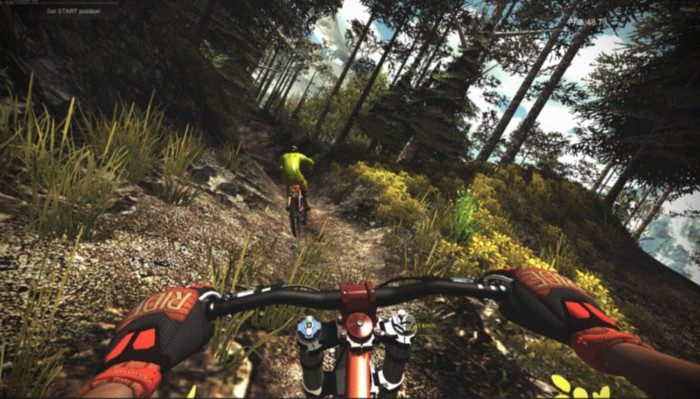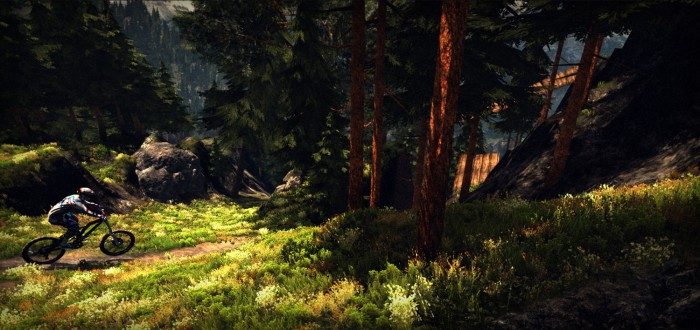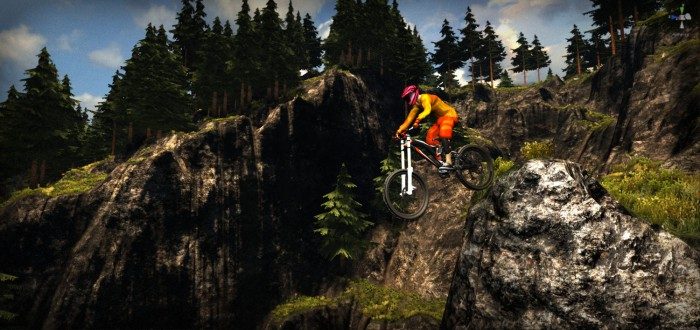Not like taking a few jumps on a raked path in the woods behind my house like I used to do as a kid—I mean really mountain biking, the kind of thing you’d see on a GoPro commercial. The kind of thing that would almost certainly result in my death if I tried it without practice. Thanks to a motion bike and a VR headset, I got to taste the thrill without the risk. But can I really say “I went mountain biking”?
First, let’s talk about the setup. I was riding Activetainment’s B\01 bike which actuates forward and backward based on incline and has pedals, gears, and software-controlled resistance, meaning it can make it hard to pedal as I’m going uphill and easy when going downhill, you know… like a real bike. You can also lean left and right into turns… as you would on a real bike. The company teamed up with MTB Freeride, an in-development mountain biking game that’s actually rather gorgeous and aims for realistic riding physics.
The other component was the Oculus Rift DK2 VR headset, which MTB Freeride supports natively. I tried the monitor-based version of the system to first get a feel for the bike and controls. Naturally, the screened experience didn’t hold a candle to the world within the DK2.
After putting on the headset, I was immersed in a mountain biker’s paradise, a highland region with steep downhill roads, broad turns alongside deadly falls, forest trails with multiple jumps and paths, and even some death-defying ramps. As I started out on the bike, I shifted to increase my resistance so I could get a solid workout. I was fairly impressed with the bike’s ability to pitch forward and back with the in-game terrain. The pitching sometimes felt sluggish, but when things lined up, it made climbing and descending inclines along the wooded path feel natural, and I could anticipate and lean into jumps as I would expect to on a real bike. Better than the pitching was feedback of the terrain below me. As I ran over sticks, rocks, and streams, I could convincingly feel the bike bump along as I went.
You can lean left and right into turns which works well most of the time. Without centrifugal force to right the bike after rounding a turn the B\01 relies instead on a spring-like system that pushes back as you lean into a turn. At times, too much learning would cause a sort of ‘bounce back’ from the spring which didn’t replicate the feeling of a bike very much. This happened especially when standing while pedaling, probably due to a raised center of gravity that more easily overcame the spring’s resistance. But after time I learned the right amount of tilt needed for a natural feeling of riding into a turn.
There were feelings of free-fall when I launched from an especially tall platform that landed me into a steep wooden ramp that turned into an inverted loop (it turned out to be quite difficult to round the loop entirely). In free-fall, with the bike pointed down and theOculus Rift allowing me to actually look down, the only thing missing was real inertia—and a sense that my life was in grave danger.
*
By the end of my time on the bike I had some sweat to show for it and a good bit of fun. But did I really go mountain biking?
This experience got me thinking about whether or not virtual experiences can be counted as their real life counterparts. If I meet up with a group of people in VR for a meeting, is that fundamentally different than meeting with them in real life? If so, why? After all, a few simple cues in a social VR environment can make you feel like you’re standing right beside other people, even if they’re physically located elsewhere.
Much of the feedback of actual mountain biking was present during my ride. Sure, the feedback could be more accurate, and there’s still missing sensory information, like the wind through my hair and a certain set of forces on my body, but at what point is a virtual experience real enough to be… well, real?
I doubt we’ll ever be able to draw a hard line in the sand, but one way we might measure the ‘realness’ of a simulation could be to see how well it prepares us to perform the real thing.
Simulations have been used extensively for many years to train pilots, both civilian and military. Many of these simulators go far beyond a VR headset, using displays that sit outside the windows of a replica cockpit. There’s actually an entire certification system for what’s called the Full Flight Simulator, which defines to what extent the real experience is simulated. By the Federal Aviation Administration’s standards, FFS systems range from levels A through D—with D being the highest—and have requirements like motion simulation with 6 degrees of freedom, a 150 degree horizontal field of view, and complex aerodynamic modeling capable of providing feedback to the pilot’s joystick.
Can pilots who have spent adequate time in a level D FFS say they’ve flown a plane? Aviation agencies worldwide definitely agree that the answer is closer to ‘yes’ than it is to ‘no’, at least as far as certifying someone as ready to take control of a real plane.
Did my experience on a VR mountain bike prepare me for the real thing? Certainly not fully in my mere 10 minute session, but I would argue that there’s lot’s of useful information to extract from the experience that would carry over to the real world, even with this limited simulation. Things like becoming aware of varying traction on different surface types (not knowing the feeling of traction itself, but being aware of changing from one surface to another), knowing best when to brake and shift, becoming familiar with a particular course, learning how to safely pass and be passed, and even how many calories I might burn on said course could all be simulated with a system like the one I tried above.
So did I really go mountain biking? By some metrics, I believe the answer is yes. With enough time in the virtual reality mountain biking experience, I believe I would measurably perform better and safer than someone who had never gone mountain biking, be it virtual or real. In that sense, the simulation is able to teach me things that I could otherwise only learn from the real thing. Of course, by other metrics, the answer is no. One day we may close the gap to the point that there is no doubt that your virtual experience was a real one. Meanwhile, my time mountain biking in virtual reality has made me want to try the real thing, and has perhaps, in a small way, even better equipped me to do so—and that’s a real result to come from the simulation no matter how you look at it.









